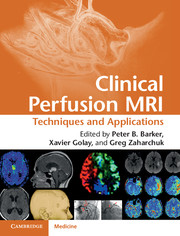Book contents
- Frontmatter
- Contents
- List of Contributors
- Foreword
- Preface
- List of Abbreviations
- Section 1 Techniques
- Section 2 Clinical applications
- 8 MR perfusion imaging in neurovascular disease
- 9 MR perfusion imaging in neurodegenerative disease
- 10 MR perfusion imaging in clinical neuroradiology
- 11 MR perfusion imaging in oncology: neuro applications
- 12 MR perfusion imaging in oncology: applications outside the brain
- 13 MR perfusion imaging in breast cancer
- 14 MR perfusion imaging in the body: kidney, liver, and lung
- 15 MR perfusion imaging in cardiac diseases
- 16 MR perfusion imaging in pediatrics
- Index
- References
8 - MR perfusion imaging in neurovascular disease
from Section 2 - Clinical applications
Published online by Cambridge University Press: 05 May 2013
- Frontmatter
- Contents
- List of Contributors
- Foreword
- Preface
- List of Abbreviations
- Section 1 Techniques
- Section 2 Clinical applications
- 8 MR perfusion imaging in neurovascular disease
- 9 MR perfusion imaging in neurodegenerative disease
- 10 MR perfusion imaging in clinical neuroradiology
- 11 MR perfusion imaging in oncology: neuro applications
- 12 MR perfusion imaging in oncology: applications outside the brain
- 13 MR perfusion imaging in breast cancer
- 14 MR perfusion imaging in the body: kidney, liver, and lung
- 15 MR perfusion imaging in cardiac diseases
- 16 MR perfusion imaging in pediatrics
- Index
- References
Summary
Introduction: Clinical background: what are the diagnostic issues?
A wide variety of vascular diseases can affect the central nervous system. These include acute ischemic stroke, the third most common cause of death in the developed world. The key diagnostic question for acute stroke patients is to determine whether they will benefit from therapies aimed at vessel recanalization and tissue reperfusion [1]. Intravenous (IV) tissue plasminogen activator (tPA) is the only US Food and Drug Administration (FDA)-approved treatment for acute stroke, but must be administered within the 3–4.5-hr time period. However, most stroke victims miss this window or do not have a clearly defined time of onset. In this large group of patients, the presence of a significant mismatch between the volume of under-perfused but not yet infarcted tissue identified by MR imaging may identify patients who may still benefit from tPA [2, 3]. This so-called “diffusion-perfusion mismatch” approach is the dominant paradigm for stroke imaging. Of paramount importance for acute stroke triage is a short MR protocol and near-immediate post-processing such that information regarding large vessel status, ischemic damage, and tissue perfusion is available within minutes [4].
- Type
- Chapter
- Information
- Clinical Perfusion MRITechniques and Applications, pp. 127 - 163Publisher: Cambridge University PressPrint publication year: 2013
References
- 1
- Cited by



